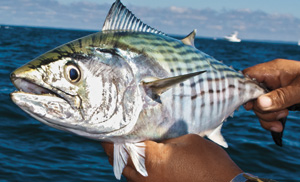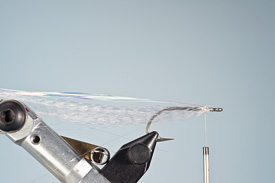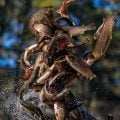Tying The Surf Candy
 IN A TWIST of fly-tying history, a fly originally developed for the unsophisticated tastes of bluefish became the most effective fly for the wary, sharp-eyedmembers of the tuna family, like bonito, false albacore, and small bluefin tuna. When Bob Popovics came back to Seaside Park, New Jersey, from Vietnam in 1970, no one in his area even knew how to tie a Deceiver. At first, Popovics tied up some Joe Brooks Blonde series bucktails, as that was the only saltwater fly pattern he had seen. Striped bass were at a historic low at that time, but there were plenty of big bluefish, so Popovics had to satisfy himself with these strong, aggressive fish with tiny razor-sharp teeth. After a couple of shots at fish the fly had to be replaced, and Popovics was getting frustrated with the frequent fly changes.
IN A TWIST of fly-tying history, a fly originally developed for the unsophisticated tastes of bluefish became the most effective fly for the wary, sharp-eyedmembers of the tuna family, like bonito, false albacore, and small bluefin tuna. When Bob Popovics came back to Seaside Park, New Jersey, from Vietnam in 1970, no one in his area even knew how to tie a Deceiver. At first, Popovics tied up some Joe Brooks Blonde series bucktails, as that was the only saltwater fly pattern he had seen. Striped bass were at a historic low at that time, but there were plenty of big bluefish, so Popovics had to satisfy himself with these strong, aggressive fish with tiny razor-sharp teeth. After a couple of shots at fish the fly had to be replaced, and Popovics was getting frustrated with the frequent fly changes.
Popovics already had epoxy on his fly-tying bench. Since bluefish love big poppers, he had been tying plenty of Ka-Boom-Boom poppers (also known as Skipping Bugs), which are large cork poppers with a slanted face. At first, tiers tried to keep these flies from being destroyed by bluefish by using plastic wood and Duco cement, but later started coating the poppers with epoxy, which made a much more durable fly. “I just started with bucktail and epoxy and kept going. The first ones were ugly, but they sure worked. They had no eyes and no flash and nobody else even wanted to know how to tie them because they looked so crude,” Popovics said.
To get more translucency in his flies, Popovics began substituting polar bear hair for bucktail due to its glassy fibers, but polar bear was expensive and hard to obtain. A few years earlier, the International Agreement on the Conservation of Polar Bears had made it illegal to sell “the skins and other items of value” from polar bears, and any hair a fly tier could obtain had to be documented as sold before 1973.
In 1983, Ed Jaworowski brought Popovics a new synthetic material called Ultra Hair, which is made from translucent, slightly crinkled nylon fibers. “It looked like polar bear and I could really tie something that looked like rain bait,” said Popovics. “And the new flies never fouled. In 1988, the Surf Candy was written up in Fly Tyer magazine and it really took off. People discovered the flies were killers for bonito and false albacore, which had always been hard to catch.”
Popovics’s first Surf Candy flies were tied with white thread and had no eyes or gill markings. He later switched to clear monofilament thread, which completely disappears when coated with epoxy, and added realistic eyes and gill markings. He even developed what he calls the Full-Dress Surf Candy, which adds a realistic body of Mylar tubing with a forked tail made from a slip of hackle feather. These additional accoutrements probably didn’t add much to the effectiveness of the flies, but they did make them look very sexy on the fly counter in comparison to most of the other saltwater flies of the late 1980s.
You can tie a Surf Candy to imitate almost any baitfish, from a tiny one-inch baby sand eel to an eight-inch needlefish used for barracuda. Spreading the hair laterally just behind the eye as the epoxy is curing makes a wide baitfish, what Popovics calls a Spread Fly, and adding a metal bead or cone to the head makes a Deep Candy, a fast-sinking version.
I have a real soft spot for Surf Candies. They are elegant, durable, and fun to tie. After seven years of chasing bluefin tuna unsuccessfully, my first was taken on a small epoxy fly, a simplified Surf Candy that was tied very sparse to begin with, and that I had to trim down with scissors to make it even smaller and slimmer because the school bluefin were feeding on tiny anchovies. These flies have created successful outings out of frustrating times more than once. There is a dock inside Menemsha Harbor—where I love to fish all night for breaking striped bass under bright dockside lights—and the only fly these fish have ever taken consistently is a small Surf Candy, drawn back so slowly it’s almost fished with no retrieve at all.
Surf Candy

- Hook: Standard saltwater hook, sizes 6–2/0
- Thread: Clear monofilament, size G
- Belly: White Ultra Hair or Super Hair
- Flash Stripe: Pearl Flashabou or similar, dependingon effect and color desired
- Back: Ultra Hair or Super Hair in darkercolor to imitate back of baitfish, typically tan, brown, olive, or chartreuse
- Resin Overlay: Epoxy, blue light-cured, or UV-cured clear resin
- Eyes: Flat stick-on eyes
- Gill Slash: Line made with red waterproof marker
Deep Candy

- Hook: Standard saltwater hook, sizes 6–2/0
- Head: Tungsten cone or bead, placed on the hook shank before the thread is attached
- Thread: Clear monofilament, size G
- Belly: White Ultra Hair or Super Hair
- Flash Stripe: Pearl Flashabou or similar, depending on effect and color desired
- Back: Ultra Hair or Super Hair in darker color to imitate back of baitfish, typically tan, brown, olive, or chartreuse
- Resin Overlay: Epoxy, blue light-cured, or UV-cured clear resin
- Eyes: Flat stick-on eyes
- Gill Slash: Line made with red waterproof marker
Full Dress Surf Candy

- Hook: Standard saltwater hook, sizes 6–2/0
- Thread: Clear monofilament, size G
- Belly: White Ultra Hair or Super Hair
- Flash Stripe: Heavy (about 20-pound) monofilament, small-diameterMylar tubing, and hackle feather. Tie a hackle feather trimmed to a chevron shape to a piece of heavy monofilament, then place a drop of Super Glue or head cement at the end of a piece of thin Mylar tubing and place the hackle tip “tail” and monofilament inside theMylar after the thread core is removed. Tie the entire arrangement to the hook shank before tying on the hair for the belly or back.
- Back: Ultra Hair or Super Hair in darker color to imitate back of baitfish, typically tan, brown, olive, or chartreuse
- Resin Overlay: Epoxy, blue light-cured, or UV-cured clear resin
- Eyes: Flat stick-on eyes
- Gill Slash: Line made with red waterproof marker
Using Resins in Saltwater Flies
 There is no getting around it—working with resins is a messy process. The better you organize your workspace and the more methodically you approach the process, the happier you (and your spouse) will be. Plus, your flies will look better. First and foremost, no matter what kind of resin you use, make your flies in batches. Do all the tying and cutting for as many flies as you want to tie, then clean off your workspace and make room for the resin-coating process. If you have the space, it even makes sense to do your tying in one area and fly coating in another.
There is no getting around it—working with resins is a messy process. The better you organize your workspace and the more methodically you approach the process, the happier you (and your spouse) will be. Plus, your flies will look better. First and foremost, no matter what kind of resin you use, make your flies in batches. Do all the tying and cutting for as many flies as you want to tie, then clean off your workspace and make room for the resin-coating process. If you have the space, it even makes sense to do your tying in one area and fly coating in another.
It helps to coat your flies by holding them in a rotary vise rather than in your hand, as you can be more precise. A clean dubbing needle is more precise than a dirty one already coated with head cement or epoxy, because you want the resin to flow off the needle and onto your fly smoothly. Bright light and magnification are also essential; even though saltwater flies are large, you must be able to see all the nooks and crannies on a fly you are coating, and having great illumination makes that easier. When I’m working with resins I use two tying lamps, one coming from the right and one from the left, so I can see any little spots that I’ve missed.
There are two basic types of resin coating: two part epoxy and light-cured resins. Two-part epoxies are harder to work with; they require you to work very quickly to avoid the stuff suddenly setting up just as you are trying to apply it, which produces a gooey mess. But two-part epoxy dries very clear, it is less expensive, and it does not require an additional coat of clear nail polish or other finish once the resin has set.
Bob Popovics originally used five-minute epoxy, and he never used a drying wheel, a small device with a slow motor that rotates the flies while they dry so that any drips even themselves out as the epoxy is setting. Instead, he coated the fly, moving the epoxy around with a dubbing needle, and then rotated the vise slowly while he sat and watched the fly to make sure the epoxy distributed itself evenly. By moving the vise to one angle or another, he could even out any drips that formed. I don’t have the patience to sit in front of one fly for five minutes, so I have always used a drying wheel. The drying wheel does tend to make the bodies of the flies more round rather than the lateral compression you get by rotating them by hand (spending more time with the fly either upright or straight down so the sides don’t get as much epoxy), but I don’t mind the round shape.
I recommend that you mix a single batch of epoxy for each fly. I used to try to do two or three flies with the same batch, but I found I would either hurry too much and get sloppy or I would try to coat the third fly right when the epoxy set up and thus ruined the shape. If you really want to do a bunch of flies at one time, try 50- or 60-minute epoxy. You’ll have lots of time to fool with them, and you can add each one to the drying wheel after you finish coating it. Good drying wheels have a nice clutch feature so you can temporarily stop the rotation by holding it to add a new fly. Long-setting epoxy like this takes a full 24 hours to be tack-free, but the resulting flies are super hard and very clear.
The best way to mix epoxy is on a sticky note right under your vise, so your travel from the goo to the fly is short and any drips will fall back on the paper. You can move the note around if you have to, and when finished, you can just crumple it up and throw it in the trash. Also, when doling out drops of resin and hardener, make sure you get equal amounts of both and drop them close to each other. Having to move the epoxy across the paper introduces air bubbles, so keeping the drops close will keep bubbles out.
 Epoxy dries best in warm, dry air. If your resulting flies are tacky, even after 24 hours, your epoxy might be old, or you might have mixed it improperly, but chances are the air was too humid. Let the flies dry under a lamp, in the sun, or near a heater. I remember a fishing trip on Martha’s Vineyard when it was so humid we couldn’t get our epoxy flies to dry, so we put them in an oven at a low temperature.
Epoxy dries best in warm, dry air. If your resulting flies are tacky, even after 24 hours, your epoxy might be old, or you might have mixed it improperly, but chances are the air was too humid. Let the flies dry under a lamp, in the sun, or near a heater. I remember a fishing trip on Martha’s Vineyard when it was so humid we couldn’t get our epoxy flies to dry, so we put them in an oven at a low temperature.
Bob Popovics now prefers light-cured resins. Light-cured resins are either cured by ultraviolet light or blue spectrum light. The light is held very close to the fly and moved slowly over the top, bottom, left, and right sides to make sure every angle is cured. It takes literally seconds for the fly to cure completely. Make sure you buy the right kind of curing light (they look like little flashlights) for the type of resin you want to use. Ultraviolet light curing requires careful attention because the rays do not constrict your pupils and can cause cataracts over time, but the lights sold are well shielded and with care they are safe to use. I have used both types and the only advantage to the ultraviolet cure is that the flies are less tacky after being cured.
You can get light-cured resins in thin or thick formulas, as well as what are supposed to be “tack-free” (they don’t seem tack-free to me) or flexible formulas. The thick version is theoretically what you put on first, followed by a second coat of the thinner variety. The advantage of these formulas is that you do everything in a fly-tying vise and they cure instantly, so you can do a second coat and the top coat in a matter of minutes. Bob Popovics uses the blue spectrum light type exclusively now, and he uses the thick version for both the first and final coat. “There’s no stress, no fussing,” he said. “I can put on a coat, move it around, get it in place, go have a cup of coffee, and then go back and cure it. It doesn’t run, so I can put it just where I want it.”
All of the light-cured resins I have seen leave a tacky, greasy finish, although some more than others. This can be removed with a paper towel dipped in rubbing or denatured alcohol (or probably even vodka). The resulting finish is dull and milky and does not look as nice in a fly box, but the fly becomes almost transparent when wet. However, most tiers add a final top coat with products sold by resin manufacturers, or just a clear nail polish like SallyHansen’sHard AsNails. These dry in seconds and do not need special light to cure as they are solvent-based.Once the fly is coated, it is as clear and shiny as one made with two-part epoxy.
© The Orvis Guide to the Essential American Flies, by Tom Rosenbauer, Universe Publishing, 2011.
Buy The Orvis Guide to the Essential American Flies on MidCurrent.





















